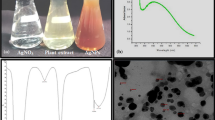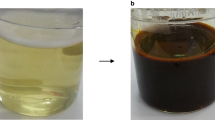Abstract
Eco-friendly biosynthetic approach for silver nanoparticles production using plant extracts is an exciting advancement in bio-nanotechnology and has been successfully attempted in nearly 41 plant species. However, an established model plant system for systematically unraveling the biochemical components required for silver nanoparticles production is lacking. Here we used Arabidopsis thaliana as the model plant for silver nanoparticles biosynthesis in vitro. Employing biochemical, spectroscopic methods, selected mutants and over-expressor plants of Arabidopsis involved in pleotropic functions and sugar homeostasis, we show that carbohydrates, polyphenolics and glyco-proteins are essential components which stimulated silver nanoparticles synthesis. Using molecular genetics as a tool, our data enforces the requirement of sugar conjugated proteins as essentials for AgNPs synthesis over protein alone. Additionally, a comparative analysis of AgNPs synthesis using the aqueous extracts of some of the plant species found in a brackish water ecosystem (Gracilaria, Potamogeton, Enteromorpha and Scendesmus) were explored. Plant extract of Potamogeton showed the highest potential of nanoparticles production comparable to that of Arabidopsis among the species tested. Silver nanoparticles production in the model plant Arabidopsis not only opens up a possibility of using molecular genetics tool to understand the biochemical pathways and components in detail for its synthesis.




Similar content being viewed by others
References
Abdel-Halim ES, El-Rafie MH and Al-Deyab SS 2011 Polyacrylamide/guar gum graft copolymer for preparation of silver nanoparticles. Carbohydr. Polym. 85 692–697
Alqadi MK, Abo Noqtah OA, Alzoubi FY, Alzouby J and Aljarrah K 2014 pH effect on the aggregation of silver nanoparticles synthesized by chemical reduction. Mater. Sci- Poland. 32 107–111
Bradford MM 1976 A rapid and sensitive method for the quantitation of microgram quantities of protein utilizing the principle of protein-dye binding. Annu. Rev. Biochem. 72 248–254
Chandran SP, Chaudhary M, Pasricha R, Ahmad A and Sastry M 2006 Synthesis of gold nanotriangles and silver nanoparticles using Aloe vera plant extract. Biotechnol. Prog. 22 577–583
Chung M, Park I, Seung-Hyun K, Thiruvengadam M and Govindasamy R 2016 Plant-mediated synthesis of silver nanoparticles: their characteristic properties and therapeutic applications I. Nanoscale Res. Lett. 11 40–53
Fornara F, Panigrahi KCS, Gissot L, Sauerbrunn N, Ruhl M, Jarillo JA and Coupland G 2009 Arabidopsis DOF transcription factors act redundantly to reduce CONSTANS expression and are essential for a photoperiodic flowering response. Dev. Cell. 17 75–86
Gil KE, Park MJ, Lee HJ, Park YJ, Han SH, Kwon YJ, Seo PJ, Jung JH and Park CM 2017 Alternative splicing provides a proactive mechanism for the diurnal CONSTANS dynamics in Arabidopsis photoperiodic flowering. Plant J. 89(1) 128–140
Guillemaut P and Marchal Drouard L 1992 Isolation of plant DNA: a fast, inexpensive, and reliable method. Plant Mol. Biol. Report. 10 60–65
Jansson PE, Stenutz R and Widmalm G 2006 Sequence determination of oligosaccharides and regular polysaccharides using NMR spectroscopy and a novel Web-based version of the computer program CASPER. Carbohydr. Res. 341 1003–1010
Kareru PG, Keriko JM, Gachanja AN and Kenji GM 2007 Direct detection of triterpeno idsaponins in medicinal plants. Afr. J. Tradit.Complement Altern. Med. 5 56–60
Ku Y, Jansen O, Oles CJ, Lazar EZ and Rader JI 2003 Precipitation of insulins and oligo glucoses by ethanol and other solvents. Food Chem. 81 125–132
Kumar A, Singh A, Panigrahy M, Sahoo PK and Panigrahi KCS 2018 Carbon nanoparticles influence photomorphogenesis and flowering time in Arabidopsis thaliana. Plant Cell Rep. https://doi.org/10.1007/s00299-018-2277-6
Kumar AA, Meena VS, Chattopadhyay S and Panigrahi KC 2012 Novel immunomodulatory effect of Gracilariaverrucosa and Potamogetonpectinatus extracts on in vitro activation of T cells. Int. J. Life Sci. Pharma. Res. 2 233–239
Li S, Shen Y, Xie A, Yu X, Qiu L, Zhang L and Zhang Q 2007 Green synthesis of silver nanoparticles using Capsicum annuum L. extract. Green Chem. 9 852–858
Lodhi MA, Ye GN, Weeden NF and Reisch BI 1994 A simple and efficient method for DNA extraction from grapevine cultivars and Vitis species. Plant Mol. Bio. Rep. 12 6–13
Miller GL 1952 Use of dinitrosalicylic acid reagent for determination of reducing sugar. Annals Chem. 31 426–428
Mishra P and Panigrahi KC 2015 GIGANTEA—an emerging story. Front. Plant Sci. 6 8–23
Mock JJ, Barbic M, Smith DR, Schultz DA and Schultz SJ 2002 Shape effect in palms resonance of individual colloidal silver nanoparticles. J. Chem. Phys. 16 6755–6759
Morones JR, Elechiguerra JL, Camacho A, Holt K, Kouri JB, Ramirez JT and Yacaman MJ 2005 The bactericidal effects on silver nanoparticles. Nanotechnology 16 2346–2353
Panigrahi KC 1998 Auxin-binding and GTP-binding proteins in plants. Ph.D. thesis awarded by University of Mumbai, India
Sambrook J, Fritsch EF and Maniatis T 1989 Current protocols in molecular biology; in J Sambrook Molecular cloning: a laboratory manual (Cold Spring Harbor Laboratory Press, New York)
Sastry M, Ahmad A, Khan IM and Kumar R 2003 Biosynthesis of metal nanoparticles using fungi and actinomycete. Curr. Sci. 85(2) 162–170
Shameli K, Ahmad M, Al-Mulla EAJ, Ibrahim NA, et al. 2012 Green biosynthesis of silver nanoparticles using Callicarpamaingayi stem bark extraction. Molecules 17 8506–8517
Shankar SS, Ahmad A and Sastry M 2003 Geranium leaf assisted biosynthesis of silver nanoparticles. Biotechnol. Prog. 19 1627–1631
Sharma VK, Yngard RA and Lin Y 2009 Silver nanoparticles green synthesis and their antimicrobial activities. Adv. Colloid Interface Sci. 145 83–96
Singaravelu G, Arockiamary JS, Kumar VG and Govindaraju K 2007 A novel extracellular synthesis of mono disperse gold nanoparticles using marine alga, Sargassum wightii Greville. Colloids Surf. B Biointerface. 57 97–101
Singh M, Sinha I and Manda RK 2009 Role of pH in the green synthesis of silver nanoparticles. Mater. Listy. 63 425–427
Tripathy A, Chandrasekaran N, Raichur AM and Mukherjee A 2009 Antibacterial applications of silver nanoparticles synthesized by aqueous extract of Azadirachta (Neem) leaves. J. Biomed. Nanotechnol. 5 93–98
Tseng TS, Salome PA, McClung CR and Olszewski NE 2004 SPINDLY and GIGANTEA interact and act in Arabidopsis thaliana pathways involved in light responses, flowering, and rhythms in cotyledon movements. Plant Cell. 16 1550–1563
Yousefzadi M, Rahimi Z and Ghafori V 2014 The green synthesis, characterization and antimicrobial activities of silver nanoparticles synthesized from green alga Enteromorpha flexuosa (wulfen) J. Agardh. Mater. Listy. 137 1–4
Acknowledgements
This work was supported by Department of Biotechnology, Ministry of Science and Technology, Grant Number: BT/PR15236/BRB/10/916/2011. We thank Department of Atomic Energy, India, and NISER for the experimental facility offered at the institute. We also would like to thank Prof. PV Satyam from the Institute of Physics, Bhubaneswar, for their help in conducting the FESEM.
Author information
Authors and Affiliations
Corresponding author
Additional information
Communicated by BJ RAO.
Corresponding editor: BJ RAO
Electronic supplementary material
Below is the link to the electronic supplementary material.
Rights and permissions
About this article
Cite this article
Kumar, A., Kumar, A.A., Nayak, A.P. et al. Carbohydrates and polyphenolics of extracts from genetically altered plant acts as catalysts for in vitro synthesis of silver nanoparticle. J Biosci 44, 6 (2019). https://doi.org/10.1007/s12038-018-9826-6
Received:
Accepted:
Published:
DOI: https://doi.org/10.1007/s12038-018-9826-6




